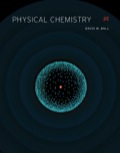
Construct the symmetry-adapted linear combination molecular orbitals for hydrogen sulfide,
Interpretation:
The symmetry-adapted linear combination molecular orbitals for hydrogen sulfide are to be constructed.
Concept introduction:
A symmetry operation is defined as an action on an object to reproduce an arrangement that is identical to its original spatial arrangement. The spatial arrangement of the object remains identical after a symmetry operation. The point of reference through which a symmetry operation takes place is termed as a symmetry element.
Answer to Problem 13.71E
The symmetry-adapted linear combination molecular orbitals for hydrogen sulfide with
The symmetry-adapted linear combination molecular orbitals for hydrogen sulfide with
The symmetry-adapted linear combination molecular orbitals for hydrogen sulfide with
Explanation of Solution
The character table for
The structure of
![]()
Figure 1
The geometry of hydrogen selenide is bent due to presence of two lone pair of electrons. The
The atomic orbitals of
The six linear combinations can be obtained from the above table as shown below.
The linear combination for
The first and second combinations are the same. The fourth and fifth combinations are exactly zero. Therefore, the unique wavefunctions after the simplification for
The table for
The six linear combinations can be obtained from the above table as shown below.
The linear combination for
All combinations are exactly zero.
The table for
The six linear combinations can be obtained from the above table as shown below.
The linear combination for
The third, fifth and sixth combinations are exactly zero. Therefore, the unique wavefunctions after the simplification for
The table for
The six linear combinations can be obtained from the above table as shown below.
The linear combination for
All combinations except the fifth combination are exactly zero. Therefore, the unique wavefunctions after the simplification for
The symmetry-adapted linear combination molecular orbitals for hydrogen sulfide with
The symmetry-adapted linear combination molecular orbitals for hydrogen sulfide with
The symmetry-adapted linear combination molecular orbitals for hydrogen sulfide with
Want to see more full solutions like this?
Chapter 13 Solutions
EBK PHYSICAL CHEMISTRY
- Determine if the following species have permanent dipole moments. a Dichloromethane, CH2Cl2 b Chlorobenzene, C6H5Cl c Ammonia, NH3 d Carbon dioxide, CO2.arrow_forwardMolecular Orbital Theory (See Examples 9.49.6.) The hydrogen molecular ion, H2+, can be detected spectroscopically. Write the electron configuration of the ion in molecular orbital terms. What is the bond order of the ion? Is the hydrogenhydrogen bond stronger or weaker in H2+ than in H2s?arrow_forwardDetermine if the following species have permanent dipole moments. a The carbonate ion, CO32 b The phosphate ion, PO43 c Uranium hexafluoride, UF6 d Bromine, Br2.arrow_forward
- Aspirin, or acetylsalicylic acid, has the formula C9H8O4 and the skeleton structure (a) Complete the Lewis structure and give the number of bonds and bonds in aspirin. (b) What is the hybridization about the CO2H carbon atom (colored blue)? (c) What is the hybridization about the carbon atom in the benzene-like ring that is bonded to an oxygen atom (colored red)? Also, what is the hybridization of the oxygen atom bonded to this carbon atom?arrow_forwardIn the molecular orbital mode l, compare and contrast bonds with bonds. What orbitals form the bonds and what orbitals form the bonds? Assume the z-axis is the internuclear axis.arrow_forwardWhat modification to the molecular orbital model was made from the experimental evidence that B2 is paramagnetic?arrow_forward
- Which is the more correct statement: The methane molecule (CH4) is a tetrahedral molecule because it is sp3 hybridized or The methane molecule (CH4) is sp3 hybridized because it is a tetrahedral molecule? What, if anything, is the difference between these two statements?arrow_forwardSolid sulfur normally consists of crystals of S8 molecules, but when heated strongly, the solid vaporizes to give S2 molecules (among other molecular species). Describe the bonding in S2 in molecular orbital terms, assuming the orbitals are analogous to those of the preceding period. What would you expect to happen to the sulfur sulfur bond length if two electrons were added to give the S22 ion? What would you expect to happen to the bond length if, instead, two electrons were taken away to give S22+?arrow_forward
 Chemistry & Chemical ReactivityChemistryISBN:9781133949640Author:John C. Kotz, Paul M. Treichel, John Townsend, David TreichelPublisher:Cengage Learning
Chemistry & Chemical ReactivityChemistryISBN:9781133949640Author:John C. Kotz, Paul M. Treichel, John Townsend, David TreichelPublisher:Cengage Learning Chemistry & Chemical ReactivityChemistryISBN:9781337399074Author:John C. Kotz, Paul M. Treichel, John Townsend, David TreichelPublisher:Cengage Learning
Chemistry & Chemical ReactivityChemistryISBN:9781337399074Author:John C. Kotz, Paul M. Treichel, John Townsend, David TreichelPublisher:Cengage Learning Principles of Modern ChemistryChemistryISBN:9781305079113Author:David W. Oxtoby, H. Pat Gillis, Laurie J. ButlerPublisher:Cengage Learning
Principles of Modern ChemistryChemistryISBN:9781305079113Author:David W. Oxtoby, H. Pat Gillis, Laurie J. ButlerPublisher:Cengage Learning Chemistry: An Atoms First ApproachChemistryISBN:9781305079243Author:Steven S. Zumdahl, Susan A. ZumdahlPublisher:Cengage Learning
Chemistry: An Atoms First ApproachChemistryISBN:9781305079243Author:Steven S. Zumdahl, Susan A. ZumdahlPublisher:Cengage Learning ChemistryChemistryISBN:9781305957404Author:Steven S. Zumdahl, Susan A. Zumdahl, Donald J. DeCostePublisher:Cengage Learning
ChemistryChemistryISBN:9781305957404Author:Steven S. Zumdahl, Susan A. Zumdahl, Donald J. DeCostePublisher:Cengage Learning





